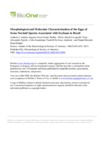Por favor, use este identificador para citar o enlazar este ítem:
http://www.alice.cnptia.embrapa.br/alice/handle/doc/973974Registro completo de metadatos
| Campo DC | Valor | Lengua/Idioma |
|---|---|---|
| dc.contributor.author | ROLIM, A. A. S. G. | pt_BR |
| dc.contributor.author | YANO, S. A. C. | pt_BR |
| dc.contributor.author | SPECHT, A. | pt_BR |
| dc.contributor.author | ANDRADE, C. G. T. de J. | pt_BR |
| dc.contributor.author | SOSA-GOMEZ, D. R. | pt_BR |
| dc.date.accessioned | 2013-12-16T22:30:00Z | - |
| dc.date.available | 2013-12-16T22:30:00Z | - |
| dc.date.created | 2013-12-16 | pt_BR |
| dc.date.issued | 2013 | pt_BR |
| dc.identifier.citation | Annals of the Entomological Society of America, v. 106, n. 5, p. 643-651, 2013. | pt_BR |
| dc.identifier.uri | http://www.alice.cnptia.embrapa.br/alice/handle/doc/973974 | pt_BR |
| dc.description | The most important species of Lepidoptera that attack soybean, in descending order of importance, are Chrysodeixis includens (Walker), Anticarsia gemmatalis Hübner, Spodoptera cosmioides (Walker), Spodoptera eridania (Stoll), and Spodoptera albula (Walker). In addition, Rachiplusia nu (Guenée) is one of the most common Plusiinae in the southern region of Brazil, encompassing the states of Paraná, Santa Catarina, and Rio Grande do Sul. The correct identification of these species is essential for choosing the appropriate control measures, as they differ in their susceptibility to insecticides and biological control agents. To distinguish Lepidoptera species commonly found in Brazil, the eggshells of all these species were morphologically characterized by scanning electron microscopy. Diagnostic characters for differentiating species include shape of rosette petals, number of primary cells, number of secondary cells, number of ribs, and rosette diameter. Also, a molecular diagnostic method using polymerase chain reaction and restriction fragment length polymorphism (PCR?RFLP) analysis was developed to distinguish noctuid species commonly found in Brazil. A 658-bp region of the mitochondrial DNA cytochrome oxidase subunit I gene was amplified using PCR and then sequenced. The five Lepidoptera species were distinguished by restriction enzymes Bpm I and MboI. RFLPs produced by Bpm I endonuclease were useful to discriminate species from within Spodoptera (S. cosmioides, S. eridania, and S. albula) and R. nu from C. includens. However, Bpm I did not digest the amplicons from S. eridania and C. includens, which were discriminated by RFLP patterns produced by the restriction enzyme MboI. PCR-RFLP can be performed in a short period, and it is useful to distinguish the most important Brazilian Lepidoptera soybean pests. | pt_BR |
| dc.language.iso | eng | eng |
| dc.rights | openAccess | eng |
| dc.subject | Lepidotero | pt_BR |
| dc.title | Morphological and molecular characterization of the eggs of some Noctuid Species associated with soybean in Brazil. | pt_BR |
| dc.type | Artigo de periódico | pt_BR |
| dc.date.updated | 2013-12-16T22:30:00Z | pt_BR |
| dc.subject.thesagro | Soja | pt_BR |
| dc.subject.thesagro | Praga de planta | pt_BR |
| dc.subject.thesagro | Phytophthora | pt_BR |
| dc.subject.thesagro | Pseudoplusia Includens | pt_BR |
| dc.subject.thesagro | Spodoptera Eridania | pt_BR |
| dc.subject.nalthesaurus | Lepidoptera | pt_BR |
| dc.subject.nalthesaurus | Rachiplusia | pt_BR |
| dc.subject.nalthesaurus | Spodoptera albula | pt_BR |
| dc.subject.nalthesaurus | Plant pests | pt_BR |
| dc.subject.nalthesaurus | Soybeans | pt_BR |
| dc.subject.nalthesaurus | Brazil | pt_BR |
| dc.subject.nalthesaurus | Spodoptera cosmioides | pt_BR |
| riaa.ainfo.id | 973974 | pt_BR |
| riaa.ainfo.lastupdate | 2013-12-16 | pt_BR |
| dc.identifier.doi | 10.1603/AN13049 | pt_BR |
| dc.contributor.institution | ADRIAN AUGUSTO SOSA GOMEZ ROLIM, ESALQ - USP; SILVIA AKIMI CAVAGUCHI YANO, CNPSo; ALEXANDRE SPECHT, CPAC; CELIA GUADALUPE TARDELLI DE JESUS ANDRADE, UEL; DANIEL RICARDO SOSA GOMEZ, CNPSO. | pt_BR |
| Aparece en las colecciones: | Artigo em periódico indexado (CPAC)  | |
Ficheros en este ítem:
| Fichero | Descripción | Tamaño | Formato | |
|---|---|---|---|---|
| 33766.pdf | 1,02 MB | Adobe PDF |  Visualizar/Abrir |









